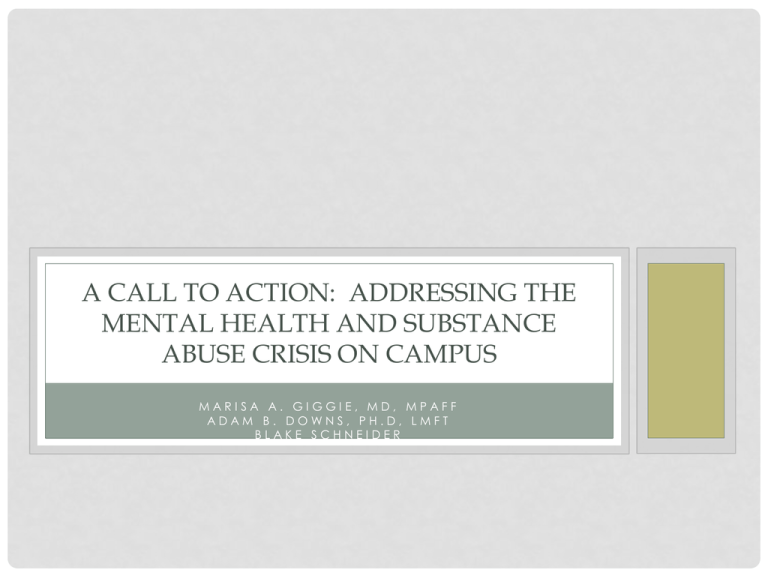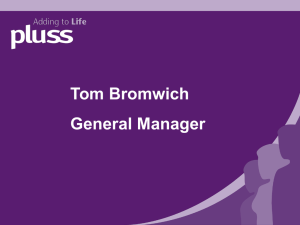presentation ( format)
advertisement

A CALL TO ACTION: ADDRESSING THE MENTAL HEALTH AND SUBSTANCE ABUSE CRISIS ON CAMPUS MARISA A. GIGGIE, MD, MPAFF ADAM B. DOWNS, PH.D, LMFT BLAKE SCHNEIDER OVERVIEW •Statement of Need (Giggie) •Current Services (Downs) •Student Perspective (Schneider) GOALS • Review of substance use problem on college campuses • Review psychiatric problems common in emerging adults • Discuss co-morbidity between substance use and psychiatric illness • Discuss importance of addressing BOTH substance use and other psychiatric disorders OVERVIEW OF PROBLEM “Amanda” 20 year old sophomore who overdosed on heroin found dead by sorority sister in her apartment OVERVIEW OF PROBLEM “Michael” 19 year old freshman admitted to local hospital for alcohol poisoning after fraternity party RITE OF PASSAGE SUBSTANCE USE IN COLLEGE • 18-25 y.o. – enrolled in college more likely to drink ETOH, binge & drink heavily • 2011 – 70% drank ETOH, 14% drank heavily, 22% use illicit drugs (SAMSA) • 50% full-time students 18-22 y.o. binged or abused drugs monthly SUBSTANCE USE DISORDERS IN EMERGING ADULTS • 30% met criteria for substance use d/o (2011 – SAMSA) • 23% of full-time college students have SUD vs 8.5% in general population • In 2011, 13.2 million high school students in US. 1.6 million have SUD • Only 6% receive treatment for addiction • Thousands of substance abuse prevention & treatment programs exist in US. • Only handful exist for collegiate students CONSEQUENCES OF SUBSTANCE USE • • • • • Legal Offenses Health Problems Academic Problems Unintentional Injury or Death Intentional Injury or Death • Co-occur with psychological disorders CO-OCCURRENCE OF SUBSTANCE USE AND OTHER PSYCHIATRIC DISORDERS • Selfmedication hypothesis • High-risk hypothesis • Both REWARD PATHWAY • Mesolimbic Pathway • Ventral Tegmental Area (VTA) → Nucleus Accumbens (NAcc)→Dopamine (DA) • Stimulants stimulate NAcc directly • Nicotine & ETOH stimulate VTA • Opiates & THC work at VTA & some effects on NAcc PATHWAYS ADDICTION & THE REST OF PSYCHIATRIC ILLNESS • DA release in the NAcc “highjacks” the reward pathway • Is this separate or related to other psychiatric illnesses? • Addiction is BOTH separate and related to OTHER psychiatric illness RATES OF MENTAL ILLNESS IN EMERGING ADULTS IN COLLEGE • 2011, 17.5 million students • More than 1,100 suicides • 2012, ACHA survey, 45% hopeless, 85% overwhelmed, 80%exhausted, 30%depressed, 7%-suicidal thoughts, 6%-SIB, 1.2%attempted suicide • 24% of students seen by counselors – get rx MENTAL ILLNESS IN COLLEGE STUDENTS • 88% - counseling center directors report more severe psychological problems • In 2012, directors report an increased % of: • • • • • • • • Emergency Crises (73%) Psychiatric Medication Issues (67%) Illicit Drug Use Problems (48%) ODS Issues (59%) Sexual Abuse Issues (30%) Eating Disorders (26%) SIB (40%) Severe Psychological Problems (39%) MENTAL ILLNESS IN EMERGING ADULTS IN COLLEGE • Problems are diverse & complex • Developmental issues (identity formation, separation crises, transition problems) • Trauma & violence • Onset of severe mental illness occurs in young adulthood – Schizophrenia, Bipolar Disorder, MDD • Stressor of college can trigger psychotic/manic/depressive episode CO-MORBIDITY • SUD co-occur with psychological disorders • 18-25 year olds with any mental illness – 30% meet criteria for SUD (SAMHSA, 2011) • Co-morbidity is highest in this age group • Rates of mental illness among those with SUD vary from 40-80% • Treatment BOTH SUD and other mental illness is low in young adults – 7% 2011 • 8 million adults older than 18 had diagnosable mental illness AND SUD • 33% received mental health care only • 4% received SUD treatment only • 7% received treatment for both SUD and MI • 57% received NO TREATMENT AT ALL CASE: MALLORY • 21 year old junior with OCD, Trichotillomania, MDD, and severe Cannabis Dependence • Failed sophomore year; skipped class; smoking MJ “all day” most days, drinking ETOH socially & experimenting with other drugs • Rx by psychiatrist at home (3 hours away) – Paxil 30 mg, Xanax XR 2 mg daily. • Judicial Affairs – involved in Back-on-Track program then referred for psychiatric evaluation • Adjusted Paxil (50 mg), Added Wellbutrin and Buspar, tapering to less Xanax XR • Worked with substance abuse counselor & family JASON • 35 year old non-traditional student. Bipolar d/o. Extensive drug/ETOH use abuse hx – crack, opiates, MJ, ETOH • Involved in CRC and referred for psychiatric eval • Treated for 4 years – sober off and on but compliant with medications • Relapsed to crack use and left school • Most successful in sobriety when compliant with psychiatric treatment COLLEGIATE RECOVERY COMMUNITY (CRC) CRC • CRCs – provide environment for students in recovery to remain sober • Safe Haven promoting Abstinence • Positive Reinforcement for Sobriety • 40 + programs in the Country UA CRC CO-MORBIDITY • Rates of Co-Morbidity – unknown in CRC population • Substance Use CANNOT be considered separate from other mental health issues • Mental Health – can interfere with recovery • Students in Recovery must have mental health support & psychiatric treatment, if necessary SUBSTANCE ABUSE SERVICES • designed for students whose excessive use of substances has created serious consequences • holds substance-abusing students to a high level of accountability while providing, holistic treatment and rigorous compliance monitoring for both short and long term programs • unites campus leaders, student conduct personnel, and programming professionals SUBSTANCE ABUSE SERVICES • Students referred by Office of Student Conduct, Dean of Students Office: Student Care & Wellness, Student Health Center etc. • Meet with Dr. Adam Downs for evaluation • Placed into appropriate program based on interview and collaboration with referral source. SUBSTANCE ABUSE SERVICES • 3 Programs • Alcohol & other Drug Awareness Program (AODA) • 4-8 weeks • Education w/ monitoring • University Community Program • 12-16 weeks • Life & Coping skill development w/ monitoring • Focus on academic success • Campus Drug Court • • • • 8-10 months Diversion program through OSC or SCW Life & Coping skill development w/monitoring Focus on academic success AODA PROGRAM Program Contents: (4-8 weeks) • 4 psycho-educational classes • Random drug screens – Color Code • Center for Academic Success (CAS) • Case management (weekly) • Recovery meeting (weekly) • Individual counseling (as needed) • Psych/medical evaluations (as needed) AODA PROGRAM Psycho-Educational Groups: • Alcohol and Other Drugs: The Mind Body Connection • Pleasure Unwoven – Brain disease concept • Strength Identification workshop • Building character and changing behaviors UNIVERSITY COMMUNITY PROGRAM • Phase 1: - Understanding the Problem (4 weeks) • Individual Therapy & Group Case Management • 1 individual • 1 group • Psychiatrist for medication management as needed • Extended Assessment Phase Personality Type • • • • • Value’s Goals/Objectives Family Functioning Depression inventories Parent/Peer Attachment • Career Center • Degree Works • Strength finder • Treatment plan development UNIVERSITY COMMUNITY PROGRAM • Phase 2 – Learning the Solution (8-10 weeks) • Objective/Goals developed based on Treatment Plan • Group Therapy 2x a week • Life skill/coping skill development • Individual & Psychiatrist for medication Management as needed • Case management • • • • Academics – custom academic success plan Drug screens – color change Weekly requirements Treatment plan compliance • Family Program • Monthly updates • Family Dynamic education and support • Weekly recovery/support meetings UNIVERSITY COMMUNITY PROGRAM • Phase 3 – Applying the Solution (4-6 weeks) • Group therapy 2x week • Less case management • Present their own case management to group • Mentorship • Tutoring • Assigned a junior group member • Outreach • Service project with group CAMPUS DRUG COURT • All students have been found responsible for a dismissible violation of the Student Code of Conduct • Clinical Components are same as UCP • Length of stay is longer (8-10 months) • Involvement from Office of Student Conduct • Open Case Review (drug court) • Weekly team meetings: Representatives from OSC, UAPD, Law School Extern, Student Housing, Dean of Student office, Substance Abuse Services, Office of Counsel CAMPUS DRUG COURT • Involvement from Office of Student Conduct • Community service hours assigned (40hrs) • Open Case Review • • • • Judge (retired drug court judge) All students attend weekly Weekly updates Receive rewards/sanctions • Closed Case Review • Present application to phase up • If in noncompliance must go before the team for individual attention COLLEGIATE RECOVERY COMMUNITY (CRC) • Mission • The mission of the Collegiate Recovery Community is to support students in recovery and help them achieve their academic goals while participating in the collegiate experience without the use of drugs, alcohol, or other behavioral or process addictions. The program also provides opportunities for families to engage in and support students in their recovery and education. CRC • Goals • • • • • Support lasting recovery for addiction Aid in development of recovery & life skills Inform/educate student & community about addiction Provide service (ASAS) Raise awareness of recovery process CRC • Stats • Average Length of Sobriety for UA CRC : 5.4 years • UA CRC Grade point average: 3.67 • 100% of UA CRC student graduates have obtained jobs in their field after graduation, or have been accepted to graduate schools. Job fields of UA CRC students include engineering, finance, and marketing. A STUDENT’S PERSPECTIVE






